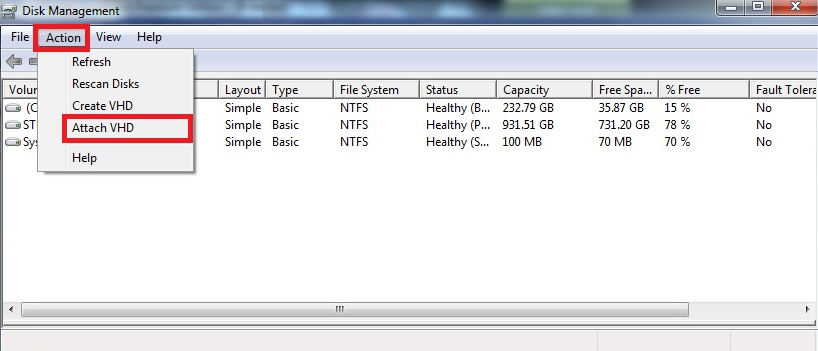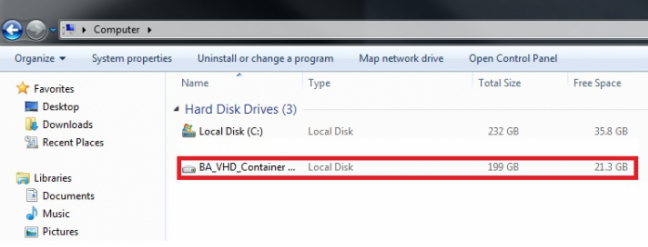BackupAssist System and Volume, File and Application, Zip Compression backups use the Volume Shadow Copy service (VSS) to back up your Hyper-V Server while it is running. BackupAssist can use these backups to restore host files, restore files into a guest using Hyper-V Advanced add-on and recover the Hyper-v guest. A System Protection bare-metal backup can be used to recover the full Hyper-V Server.
System Protection backups can use Data containers as backup destinations. BackupAssist automatically mounts Data containers when restores are performed. However, there may be times when you want to do this manually. For example, if you want to check what is inside a Data container or have it available for another task.
To manually mount a Data container:
- Open Disk Management.
- Click the Start button.
- Type diskmgmt.msc into the Search Programs and Files text box.
- Click OK.
- Open Run from the Apps screen.
- Type diskmgmt.msc into the Search Programs and Files text box.
- Click OK.
- Select Action from the Disk Management menu.
- Select the menu option Attach VHD.
- Enter the path of the Data container that you want to mount and click OK.
- Right click BA_VHD_Container, select Change Drive Letter and Paths, and select Add.
- Select a drive letter for the Data container, using the drop down box, and select OK.
For Windows Server 2008 R2, SBS 2011 and Windows 7
For Windows Server 2012 and Windows 8 and later
The Disk Management console will open.
You will now have a drive named BA_VHD_Container in your list of available drives.
You can now browse the Data container using Windows Explorer.
To learn more see, Data Container guide
Hyper-V Server Restore
Problems can arise if you try to restore a Hyper-V host to an existing server. This is because Hyper-V is integrated into Windows Server and will often have operating system dependencies. Specific Hyper-V host and guest installation options can also create compatibility problems for full Hyper-V host restores.
For these reasons, restores of Hyper-V hosts should be performed by:
- A recovery of the full Hyper-V Server rather than just restoring the Hyper-V Server application. Only a System Protection bare-metal backup can be used for a recovery. To learn more, see System Recovery
- Reinstalling the Hyper-V Server feature and then recovering the guests back to the Hyper-V host.
Other Hyper-V restores
Hyper-V host file restores
Individual host files and folders can be restored back to the Hyper-V host by following the Local and Network Files restore process. System Protection, File Protection and File Archiving backups can be used. To learn more, see Restore Local and Network files
Hyper-V Granular Restore
You can restore individual guest files back into a Hyper-V guest using the Hyper-V Advanced add-on. System and Volume, File and Application, and Zip Compression backupos can be used. To learn more, see restore Files inside Hyper-V Guests
Hyper-V guest recovery
Restoring a full guest is a recovery process. To recover a Hyper-V guest to a host, see Full VM Recovery You can also perform a Rapid VM Recovery (Legacy) of a guest using the Hyper-V Advanced add-on

